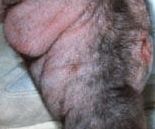Summary:
"There is a long list of diseases and conditions canine skin. If your dog is suffering from mild discomfort, then home treatment such as shampootherapy to eliminate itch and scratching is worth a try. If dog skin itch or scratching causes redness, hair loss or an interruption of your dog's normal routine, such as stopping in the middle of play to chew on the skin, then it's smart to visit a veterinarian for a prescription medication. Puppies should just about always be diagnosed by a veterinarian since a dull coat and hair indicates a case of dog worms. Demodicosis mange is also seen in puppies just after being born. For adult dogs, diagnosis of dog skin diseases are based on the appearance of the skin and if any other symptoms exist. A veterinarian will attempt to narrow the list of possible causes by taking a thorough history, with a physical exam, and diagnostic lab tests. Dog flea allergy is the leading cause, followed by other types of allergies such as environmental dog allergies (atopy) and dog food allergy. Mange causes patches of baldness, is the next leading cause and is primarily seen in puppies. Your vet will try and determine if a condition caused the skin problem, or if the problem was the result of related symptoms such as itching and scratching, which are common reactions to a dog skin allergy. Other symptoms which accompany the dog skin problems such as severe hair loss and excessive panting could indicate an underlying disorder like an endocrine disease such as hyperadrenocorticism or Cushings Disease. Treatment for dog skin conditions involve keeping the skin clean and treating the underlying cause such as bacterial infection, parasites or lump removal.
Overview
Identifying diseases and conditions canine skin can be difficult to diagnose since there are many causes. The key to understanding which condition your dog is suffering from is to do your best to match the characteristics of each cause with the symptoms exhibited by your dog. Dog skin disorders are difficult to diagnose requiring diagnosis of any underlying cause in order to cure any visible clinical symptoms.
Considerations when Diagnosing Dog Skin Diseases
In general, if your dog is suffering from skin itch, and if skin lesions are red in color and oozing pus, and is accompanied by hair loss, a trip to the veterinarian is needed as the condition is probably beyond your ability to control the problem with over the counter medications. In this case a dog skin infection has probably taken hold, requiring antibiotics and possibly short term steroid use for inflammation.
If the skin condition is limited to dog skin itch and scratching, then the first step is to suspect the beginning of a flea infestation. It's easy to miss fleas when inspecting your dog's hair, so don't be surprised if this is the cause.
If fleas are not found after combing your dog with a flea comb, consider allergy as a possible cause. For mild conditions, ask your vet about using an antihistamine (diphenhydramine). You can also bring your dog some relief with a dog colloidal oatmeal shampoo. Avoid any product that is medicated at first, since these may cause additional irritation.
Other possible causes after fleas allergy are environmental allergies (referred to as canine atopy), food allergy and domestic dog mange. Mange is caused by mites and is usually seen in young puppies with symptoms such as bald patches and secondary illnesses that are the result of the condition. To diagnose mange, your vet will need to test a skin scraping.
For advice specific to a wide range of canine skin conditions, review the symptoms, pictures and other information below. If you have a question on any Diseases and Conditions Canine Skin, fill out the form with your question at the bottom of this page.
Symptoms related to Dog Skin Disorders
Canine skin conditions tend to vary based on shape, of any lesions, condition of the skin such as crusts, scars, ulcers or scales and the dogs behavior such as itching. Specifically:
- Scratching, licking the skin and Dog Skin Itch: Dogs that scratch the face, feet ,ears and arm pits usually have some form of inhalant allergy. Dog flea allergy causes dogs to scratch or lick the tail, back, groin and thigh.
- Canine Skin Rash or red patches on skin - Red, irritated looking skin is a non-specific symptom and can be associated with any number of disorders such as mange, immune-mediated disorders (lupus, pemphigus).
- Black Crusty Skin - also known as alopecia X or Cushings Disease
- Hot Spots: (also called acute moist dermatitis) is caused by the removal of a superficial layer of skin due to scratching or biting.
- Dry, oily or flaky skin due to canine Dandruff or Seborrhea: refers to scaling skin or which occurs when skin particles accumulate on the outer layer of the skin. Dog seborrhea sicca refers to dog dandruff, while greasy or oily skin is referred to as seborrhea oleosa. Canine seborrhea is caused by allergy, hormonal problems, bacterial infections, fungus, and tumors.
- Lumps on Skin or under dog skin
- Pemphigus - This is an immune system disorder where the dog's body attacks the substance that holds skin cells together. The result is the skin literally coming apart, resulting in skin pustules and crusts, particularly around the bridge of the nose and feet. Symptoms include painful skin that is very red and crusty in appearance. Commonly effected areas of immune mediated dog skin diseases are at the ear margins, lips and nasal area. Canine lupus is another immune system related disorder with similar symptoms.
- Toenails breaking off: usually caused by fungus, bacteria or mites.
- Dog Odor Skin and Bad Smell
- Scratches rear end on bottom of rug: probably due to a full anal gland.
- Foot Problems are often caused by some type of allergy such as a food allergy
- Dog Skin Sores
- Dog Hair Loss or shedding (alopecia): Most conditions that involve canine hair loss are caused by a hormonal problem (endocrine system) such as hypothyroidism. Other causes are folliculitis which is causes by inflammation of the hair follicle due to canine ringworm or a bacterial infection. Often a cause cannot be found.
- A dry, dull-looking coat along with severe hair loss, excessive panting, a distended abdomen, a reduction of muscle mass and thin/frail skin can indicate some type of underlying disease such as hyperadrenocorticism (Cushing’s Disease) . Be sure to mention changes in coat condition as this is an indicator of something going on in your dog's body. It can also be a sign of poor nutrition.
- Patchy hair loss on the head and face is a symptom of mange. Patches of dog hair loss can also indicate ringworm or allergy.
- Dog skin scabs or crusts: this is caused by the build up of pus or skin scaling due to skin diseases such as canine pyoderma (pus filled bumps). Crusts on the ear margins can be caused by mange.
Causes of Canine Skin Conditions
- Allergy is a common cause of diseases and conditions canine skin. Types of dog skin allergies include:
- Dog Food Allergy
- Canine Skin Allergy
- Atopic dermatitis: this is an allergy to something that is inhaled (hypersensitivity to inhaled allergens).
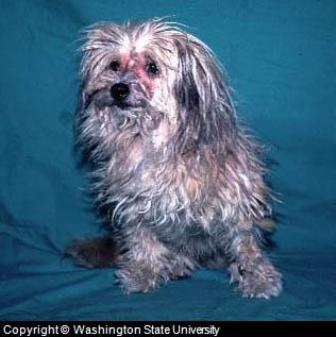
Source: Washington State University
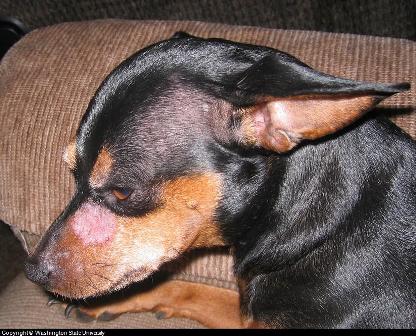
Source: Washington State University
- Bacterial Dog Skin Infections: usually due to some other condition suppressing the immune system
- Canine Skin Cysts: these are benign (non-cancerous) lumps under the skin
- Dog Skin Warts: these are benign (non-cancerous) bumps on the skin
- Fleas: dogs with flea bite hypersensitivity tend to bite, lick or scratch areas near the tail, groin, back and thighs.
- Acne and Dog Skin Pimples
- Canine Skin Parasites
- Ticks, Mites and Lice
- Acne: some dogs can get acne with pimples around the mouth and chin. Use a dab of human benzoyl peroxide to see if the condition gets better.
- Yeast Infection: spots on the feet.
- Seborrhea: scars, bumps and pimples on the skin in addition to flaky skin and itching.
- Immune-mediated diseases and conditions canine skin problems: sores on top of the muzzle and possible spreading to the face. Pyoderma is an immune mediated skin condition often seen in puppies.
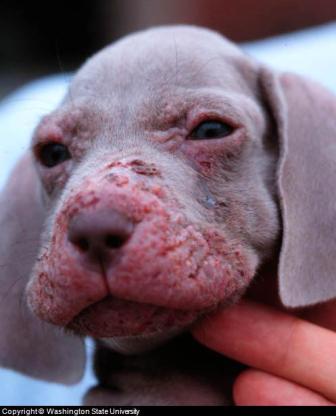
Source: Washington State University
- Dry foot pads: a dog’s feet are supposed to be dry and possibly cracked. You usually only need to treat the feet if your pet is in pain. Lotions or ointments are licked off by your pet.
- Small red hairless area (s): Could be mange (scabies). Other symptoms include hairless area with pimples, thick skin and puss, Scaling around the eyes, mouth and front legs, itching. See a photo of mange.
Diagnosis of Diseases and Conditions Canine Skin
Your vet will examine your dog’s skin carefully as part of a complete examination. The exam will start with a thorough history since many dog skin disorders are more common in certain breeds and at specific ages. There is also a higher incidence of specific types of dog skin problems in some breeds.
In order to properly diagnose diseases and conditions canine skin, various tests may be needed. Tests might include:
- Examining skin under a special light (a woods lights): this is done to check for certain fungal infections such as ringworm.
- Dog skin biopsy: in this test, a needle is used to remove cells from a lump to be examined by a pathologist. This can determine if a lump is cancerous or if it is just a cyst or wart.
- Blood tests: might be done to check for infections and certain nutrient deficiencies.
If you keep your dog clean and it continues to smell or have a greasy coat then your pet is probably suffering from parasites, seborrhea or a skin infection.
The probable cause of diseases and conditions canine skin problems is often associated with the age of the dog.
Diseases and Conditions Canine Skin By Age |
|
|---|---|
| Dog Age | Common cause of Dog Skin Disorders |
| Under 6 months |
Dog Mange (Demodicosis) Canine Acne Juvenile Pyoderma (puss filled dog skin lumps) Ringworm (dermatophytosis) |
| Middle age dogs and young adults |
Dog skin allergy Hormonal imbalance Canine seborrhea (oily coat, crusts and scabs) |
| Older Senior Dogs |
Hair loss (alopecia) Dog Skin Tumors (neoplasms, cancer) |
Dog skin conditions are also often related to specific dog breeds. For example, the Shar Pei is know for have the most diseases and conditions canine skin problems, with allergy being the cause 67% of the time.
The location on the dog's body also provides clues as to the underlying cause of the diseases and conditions canine skin as outlined in the table below.
Diseases and Conditions Canine Skin by Body Location and Symptoms |
|
|---|---|
|
Location on Dog Body Affected and Symptoms |
Dog Skin Disease that could be causing the problem and related treatment options |
|
Papules on the Small of the back, middle of the back thighs, groin, belly, tail base 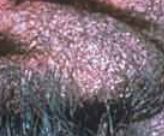
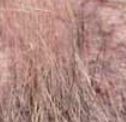
|
Flea bite hypersensitivity which is treated for itch and flea prevention. Kill fleas with a product such as a Herbal Flea Dip. |
|
Skin redness, hair loss, papules, skin crusts, all over body or in one area
|
Dog Skin Infection (try anti-bacterial dog shampoo therapy), antibiotics |
|
Localized Demodicosis (dog mange) Skin redness, hair loss and skin scaling on the dog face in less than 4 spots. |
Condition is caused by mites and is commonly referred to as dog mange. If in one area, may heal on tis own. For generalized mange consider a lime-sulfur dip such as Naturasil. |
|
Skin papule (raised area) on the ears, elbows, abdomen |
Sarcoptes mange or sabies using a lime-sulfur dip such as Naturasil. |
|
Papules on the face, ears and dog paws |
Fungal condition called Dermatophytosis treated with prescription medications that contain Grisseofulvin or Ketoconazole. Can benefit from anti-fungal dog shampoo therapy. |
|
Dog skin redness, discolored skin spot (called a macule), papules in areas where little or no hair is found, including fuild filled bumps in those areas, particularly in the dog's scrotum, chin, pelvis, paws, back of the abdomen
|
Dog skin allergies or hypersensitivity treated with anti-inflammatory steriods or identification and avoidance of the environmental allergen (if possible) |
|
Uncontrolled cell growth resulting in a skin tumor or neoplasm - referred to as a dogg mast cell tumor |
Removal with surgery |
Treatment of Diseases and Conditions of Canine Skin
The treatment of the diseases and conditions canine skin depends on the exact disease or condition. Treatment may involve oral or topical medication. It may also involve removal of any lumps or bumps from your dog’s skin. If your pet’s skin is affected by poor nutrition, treatment will involve making a correction in the diet.
There is a myth that baths are not good for diseases and conditions canine skin. This is not correct as bathing is an important part of just about every skin treatment. Shampoos are particularly effective on bacterial infections with a medicated bath 1 - 2 times per week. They also help to remove any allergens that are caught in the dog's coat.
In terms of dog skin yeast infections, a gentle herbal shampoos combined with a lime sulfur dip, both offered by Naturasil works to eliminate yeast infections and ringworm.
If the bacterial infection has progressed deep into the skin then antibiotics are needed.
You should also carefully look at your dogs diet and if it is causing any of the diseases and conditions canine skin problems. Follow this link to understand Dog Food for Skin. or sensitive skin dog food.
If all other causes are ruled out, then you might want to consider using oil for dry dog skin and this advice on finding a cure dog dry skin. You can also fill out the form below with your specific diseases and conditions canine skin question.
Have A Question about Your Dog's Skin Condition? Our Team Will Answer It for Free!
Do you have a question or comment? Share it!
Our editors will pick 1 question to answer each week. Please include your dog's age, breed, medical history, medications and if possible, a picture of the condition.
We will do our best to get back to you quickly (it depends on how many questions we receive each day). If you do require an immediate response we suggest using this online dog veterinary service that is available now.
References Diseases and Conditions Canine Skin:
Carter, G.R., Wise, D.J., and Flores, E.F. (Eds)
A Concise Review of Veterinary Virology
Carmichael, L.
Recent Advances In Canine Infectious Diseases
Melman, Dr. Steven A.
Skin Diseases of Dogs and CatsDermatology for the Small Animal Practitioner,
Mueller R.S. (Ed.)

